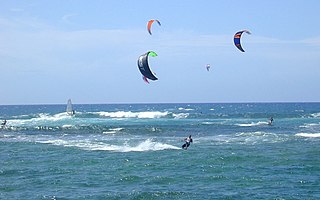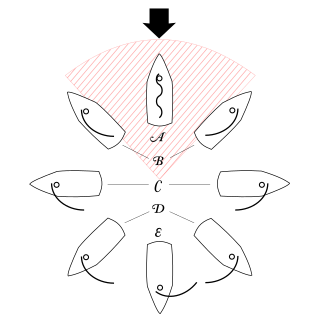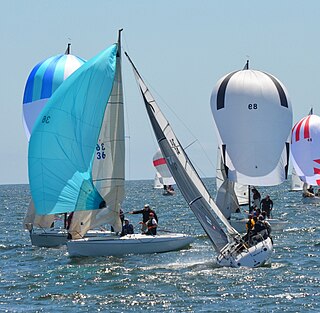
Hockey is a term used to denote a family of various types of both summer and winter team sports which originated on either an outdoor field, sheet of ice, or dry floor such as in a gymnasium. While these sports vary in specific rules, numbers of players, apparel, and playing surface, they share broad characteristics of two opposing teams using sticks to propel a ball or disk into a goal.
Roller hockey is a form of hockey played on a dry surface using wheeled skates. It can be played with traditional roller skates or with inline skates and use either a ball or puck. Combined, roller hockey is played in nearly 60 countries worldwide.

Sailing employs the wind—acting on sails, wingsails or kites—to propel a craft on the surface of the water, on ice (iceboat) or on land over a chosen course, which is often part of a larger plan of navigation.

Speed skating is a competitive form of ice skating in which the competitors race each other in travelling a certain distance on skates. Types of speed skating are long-track speed skating, short-track speed skating, and marathon speed skating. In the Olympic Games, long-track speed skating is usually referred to as just "speed skating", while short-track speed skating is known as "short track". The International Skating Union (ISU), the governing body of competitive ice sports, refers to long track as "speed skating" and short track as "short track skating".

Ice skates are metal blades attached underfoot and used to propel the bearer across a sheet of ice while ice skating.

A power kite or traction kite is a large kite designed to provide significant pull to the user.

Inline speed skating is the roller sport of racing on inline skates. The sport may also be called inline racing or speed skating by participants. Although it primarily evolved from racing on traditional roller skates, the sport is similar enough to ice speed skating that many competitors are known to switch between inline and ice speed skating according to the season.

A point of sail is a sailing craft's direction of travel under sail in relation to the true wind direction over the surface.

Figure skates are a type of ice skate used by figure skaters. The skates consist of a boot and a blade that is attached with screws to the sole of the boot. Inexpensive sets for recreational skaters are available, but most figure skaters purchase boots and blades separately and have the blades mounted by a professional skate technician.

A daggerboard is a retractable centreboard used by various sailing craft. While other types of centreboard may pivot to retract, a daggerboard slides in a casing. The shape of the daggerboard converts the forward motion into a windward lift, countering the leeward push of the sail. The theoretical centre of lateral resistance is on the trailing edge of the daggerboard.

Inline skating is a multi-disciplinary sport and can refer to a number of activities practiced using inline skates. Inline skates typically have two to five polyurethane wheels depending on the style of practice, arranged in a single line by a metal or plastic frame on the underside of a boot. The in-line design allows for greater speed and maneuverability than traditional roller skates. Following this basic design principle, inline skates can be modified to varying degrees to accommodate niche disciplines.

An iceboat is a recreational or competition sailing craft supported on metal runners for traveling over ice. One of the runners is steerable. Originally, such craft were boats with a support structure, riding on the runners and steered with a rear blade, as with a conventional rudder. As iceboats evolved, the structure became a frame with a seat or cockpit for the iceboat sailor, resting on runners. Steering was shifted to the front.

A windsport is any type of sport which involves wind-power, often involving a non-rigid airfoil such as a sail or a power kite. The activities can be land-based, on snow, on ice or on water. Windsport activity may be regulated in some countries by aviation/maritime authorities if they are likely to interfere with other activities. Local authorities may also regulate activity in certain areas, especially on crowded beaches and parks.

Tour skating is recreational long distance ice skating on natural ice. It is particularly popular in the Netherlands and the Nordic countries. It is becoming more popular in areas of North America such as New England, Southcentral Alaska, and Nova Scotia.

Inline hockey or roller hockey is a variant of hockey played on a hard, smooth surface, with players using inline skates to move and ice hockey sticks to shoot a hard, plastic puck into their opponent's goal to score points. The sport is a very fast-paced and free-flowing game and is considered a contact sport, but body checking is prohibited. There are five players including the goalkeeper from each team on the rink at a time, while teams normally consist of 16 players. There are professional leagues, one of which is the National Roller Hockey League (NRHL). While it is not a contact sport, there are exceptions, i.e. the NRHL involves fighting.

Land sailing, also known as sand yachting, land yachting or dirtboating, entails overland travel with a sail-powered vehicle, similar to sailing on water. Originally, a form of transportation or recreation, it has evolved primarily into a racing sport since the 1950s.
Bauer Hockey LLC is a manufacturer of ice hockey equipment, fitness and recreational skates and apparel. Bauer produces helmets, gloves, sticks, skates, shin guards, pants, shoulder pads, elbow pads, hockey jocks and compression underwear, as well as goalie equipment. Some of its equipment, such as its ice hockey skates, are also approved for use in the sport of ringette.

Roller skiing is an off-snow equivalent to cross-country skiing. Roller skis have wheels on their ends and are used on a hard surface, to emulate cross-country skiing. The skiing techniques used are very similar to techniques used in cross-country skiing on snow.

Wind-powered vehicles derive their power from sails, kites or rotors and ride on wheels—which may be linked to a wind-powered rotor—or runners. Whether powered by sail, kite or rotor, these vehicles share a common trait: As the vehicle increases in speed, the advancing airfoil encounters an increasing apparent wind at an angle of attack that is increasingly smaller. At the same time, such vehicles are subject to relatively low forward resistance, compared with traditional sailing craft. As a result, such vehicles are often capable of speeds exceeding that of the wind.

Forces on sails result from movement of air that interacts with sails and gives them motive power for sailing craft, including sailing ships, sailboats, windsurfers, ice boats, and sail-powered land vehicles. Similar principles in a rotating frame of reference apply to windmill sails and wind turbine blades, which are also wind-driven. They are differentiated from forces on wings, and propeller blades, the actions of which are not adjusted to the wind. Kites also power certain sailing craft, but do not employ a mast to support the airfoil and are beyond the scope of this article.
![People skate sailing, [1933] John H. Boyd (photographer) Canadians skate sailing (1933).jpg](http://upload.wikimedia.org/wikipedia/commons/thumb/0/0a/Canadians_skate_sailing_%281933%29.jpg/220px-Canadians_skate_sailing_%281933%29.jpg)



















